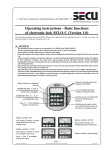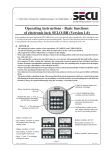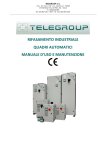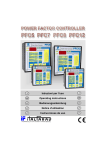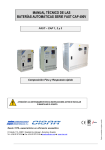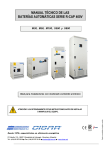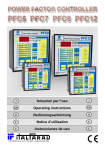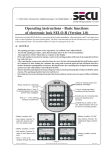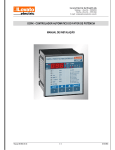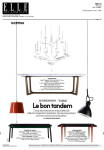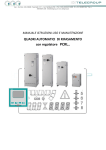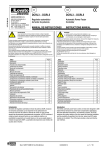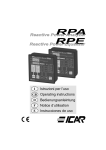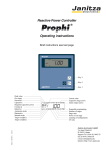Download POWER FACTOR CORRECTION SYSTEMS USER MANUAL
Transcript
Via L.. Da VINCI, 100, 50028, Tavarnelle V.P – FIRENZE – Tel. +39 055 80 71 267 /118 Fax. + 39 055 80 71 338 E‐mail [email protected] www.telegroup.it POWER FACTOR CORRECTION SYSTEMS USER MANUAL Automatic Power Factor Correction panels Pages 2 – 4 Microprocessor PFC Controller Pages 5 – 14 1 Via L.. Da VINCI, 100, 50028, Tavarnelle V.P – FIRENZE – Tel. +39 055 80 71 267 /118 Fax. + 39 055 80 71 338 E‐mail [email protected] www.telegroup.it GENERAL INFORMATION Attention!!! Proper connection and start‐up of power factor correction equipment is relatively simple yet it must not ever, under any circumstances, be left up to chance. Consequently, the device will not engage or disengage the batteries of capacitors or it will operate anomalously. In that these panels have all been tested and inspected by the manufacturer, any anomalous operation will be due to faulty connections, and in particular or to a faulty positioning of the current transformer. Therefore, we kindly request that you observe the instructions in this manual and rigorously follow them in the sequence indicated. Thank you for your kind attention and collaboration. Locate the panel in a well aerated space and far from any heat sources: good air circulation is one of the most important factors for proper and long lasting operation. Leave at least 30 cm of space around the panel, so that air may freely enter and exit the area. Do not locate the equipment in humid areas unless it has been specifically requested with a particular protection grade. 1‐ LOCATION OF THE EQUIPMENT Operational limits: - Relative humidity: max 50% at 40° C – 90% at 20° C - Altitude: max. 2000 metres a.s.l. - Transport and warehousing: temp.‐25 to +55° C 2‐ CURRENT SHORT CIRCUIT To insure that the equipment will not be subject to short circuits it is necessary to install, upstream of the power factor correction panels, whether they are fixed or automatic, a circuit of three aM NH type current limiting fuses (or other devices with similar characteristics) with suitable nominal current specifications and power to break the circuit above the presumed short circuit current. When the LCC is not known at the point of installation, it may be approximated by the LCC of the transformer (50 KA). KVAR power From 7.5 to 17.5 From 20 to 27.5 From 30 to 60 From 65 to 150 From 100 to 150 From 160 to 360 From 200 to 350 From 400 to 1000 From 100 to 125 From 150 to 175 From 200 to 350 From 400 to 500 From 550 to 1000 LCC max kA 4 5 6 10 16 20 20 40 10 16 20 40 50 KVA 50 63 100 160 200 250 315 400 500 630 800 1000 1250 1600 2000 V DC% 4 4 4 4 4 4 4 4 4 4 6 6 6 6 6 LCC kA 1.8 3.6 5.77 7.22 9.02 11.37 14.43 18.04 22.73 19.25 24.06 30.07 38.49 48.11 50.14 2 Via L.. Da VINCI, 100, 50028, Tavarnelle V.P – FIRENZE – Tel. +39 055 80 71 267 /118 Fax. + 39 055 80 71 338 E‐mail [email protected] www.telegroup.it 3 ‐ CONNECTION 1. The C.T. secondary must be earthed. 2. Power the equipment with cables of a section suitable for the label power specifications. 3. Power Supply: Three phase with neutral for equipment with a power from 7.5 to 27.5 kvar ‐ Three phase without neutral for equipment over 27.5 kvar with a power of 400 volts. 4. Anchor the power supply cables to the mains switch. IMPORTANT! In the event that the panel were to be shut down during operation, make sure that all of the batteries have been disengaged before opening the mains switch. 4‐ CHOICE, LOCATION AND CONNECTION OF THE CURRENT TRANSFORMER (CT): C.T. calibration with 5/A secondary, (to be provided by the client) must be calculated based on the average current circulating in the plant, independent of the power factor correction, keeping in mind that the range of measurement of the regulator current goes from 8% to 110% of the C.T. current. Therefore, this condition must be satisfied. Ex: there is a circulating current of 200/A; a C.T. must be chosen the current of which is between: 2500 A (8% of 2500=200/A) and 180A (110% of 180 A= 200 /A). It is a good rule to install a C.T. with twice the primary current of that which is actually circulating. The C.T. must be located upstream of the loads and the bypass that powers the power factor correction panel. All in all one must “consider” MAINS L1 L2 L3 both the inductive loads of the users as well as those of the capacitance of the capacitors. In the bypass that powers the power factor correction T.A..../5 A panel, the phase corresponding to that where the C.T. is installed must be anchored to the central terminal of the switch. Since the phases that voltmetrically power the regulator must be different from the phase where the C.T. is installed and in that in our panels this signal is drawn on the two lateral phases, it is obligatory that the corresponding phase be T.T. anchored, to the same one where the C.T. was installed, on the central terminal of the switch. This condition may be easily verified with the use QUADRO RIFASAMEN TO of a voltmeter, measuring, between the phase where the C.T. was placed and the phase anchored to the central terminal of the switch of the LOAD automatic power factor correction panel: the voltage must be “0”. The location of the C.T. is fundamental for the proper use of the equipment. The relative diagram is found in the figure to the side. In the table below some possible positions of the MAINS C. T.s that are faulty: L1 L2 L3 3 Via L.. Da VINCI, 100, 50028, Tavarnelle V.P – FIRENZE – Tel. +39 055 80 71 267 /118 Fax. + 39 055 80 71 338 E‐mail [email protected] www.telegroup.it Position 2: Even though the C.T. has been installed upstream, the corresponding phase that powers the device is not anchored to the central terminal. Position 3: The C.T. has been installed on the load line! Position 4: the C.T. has been installed on the lines that power the power factor correction panel. CONTATORE DI CORRENTE MAINS L1 L2 L3 T.A..../5 A It is often found, particularly in installations of low power equipment located near an ENEL meter in L.V., that the power supply line to the loads coincides with that which powers the power factor correction panel. In this specific case, both power supply cables must be inserted in the hole for the C.T., (for the power factor correction and for the loads) See the figure. T.T. QUADRO RIFAS AMENTO LOAD Insertion of an automatic power factor correction panel in presence of an M.V. transformer: in the event that there are capacitor banks of the fixed type, on the transformers, the C.T. necessary for the command of the automatic power factor correction device must be positioned downstream of the fixed capacitors. 4 Via L.. Da VINCI, 100, 50028, Tavarnelle V.P – FIRENZE – Tel. +39 055 80 71 267 /118 Fax. + 39 055 80 71 338 E‐mail [email protected] www.telegroup.it The figure above illustrates the connection of an automatic power factor correction device in presence of M.V. transformers connected in parallel. It is necessary to use a C.T. adder with 2 or 3 inputs according to whether there are 2 or 3 transformers, to which the output cables from the C.T. must be connected. The C.T. adder output must be connected to the automatic power factor correction panel. Set the C.T. primary (the methods for setting this parameter are described below) as the sum of the two C.T.s. PFC MICROPROCESSOR CONTROLLER 1. Attention The PCRK5 microprocessor regulator has already been pre‐set and must not under any circumstances be changed. The only parameter to set by the installer is the value of the primary for the Current Transformer (C.T.). 2. Once the device has been powered, the display will show: “CT “ (Current Transformer) flashing. 3. Pressing or directly set the value of the C.T. primary. 4. Once the setting has been made, press MAN/AUT to confirm. The device will memorise the setting and will start back up again in automatic. 5. For all of the PCRK settings and visualisations, see the relative instructions in this manual. 5 Via L.. Da VINCI, 100, 50028, Tavarnelle V.P – FIRENZE – Tel. +39 055 80 71 267 /118 Fax. + 39 055 80 71 338 E‐mail [email protected] www.telegroup.it DIAGRAM FOR THREE PHASE INSERTION Attention!! The C.T. position is on the “T” phase, whilst in our automatic panels it must be on the “S” phase. 6 Via L.. Da VINCI, 100, 50028, Tavarnelle V.P – FIRENZE – Tel. +39 055 80 71 267 /118 Fax. + 39 055 80 71 338 E‐mail [email protected] www.telegroup.it PCRK5 ‐ PCRK7 ‐ PCRK8 ‐ PCRK12 AUTOMATIC POWER FACTOR REGULATORS ATTENTION! These devices must be installed by qualified personnel, with respect for the regulations in effect for plant facilities installations, so as to avoid any damage to things or persons. The products described in this document may be changed or improved at any time. The descriptions and data in this document cannot therefore be of any contractual value DESCRIPTION – Microprocessor for automatic power factor regulator – LED Display with 3 number 7 segments. – 4 button membrane keypad. –TTL‐RS232 serial Interface for automatic set‐up and test inspection with a PC. – Internal temperature sensor – Advanced functions (capacitor overload current measurement, average weekly power factor, memorisation of maximum values. – 2 programmable relays as alarms and/or ventilation control VERSIONS PCRK5 container 96x96mm, 5 steps PCRK7 container 96x96mm, 7 steps PCRK8 container 144x144mm, 8 steps PCRK12 container 144x144mm, 12 steps INSTALLATION – For three phase activation the C.T. must be connected to the phase not used for powering the device, as indicated in the connection diagram. – The device is supplied ready to recognise the direction of the C.T. current. In the case of a cogeneration plants it is necessary to disable this function (see chapter on advanced menu) and see to the correct connection of the C.T. – The C.T. secondary must be earthed. POWERING UP – Upon commissioning, the display will show “‐‐‐‐‐‐‐ “, indicating that the setting of parameters has not yet been performed. – In this condition, it is possible to carry out a manual test of the steps for a verification of the connections. – Pressing the or buttons it is possible to activate or deactivate the steps. – ATTENTION! In this phase the control of the steps is completely manual and the device will not perform the check on the reconnection times so as to enable the discharge of the capacitors. SETTING PARAMETERS To set the parameters and render the device operative different methods may be followed: 1. MANUAL SETTING FROM THE KEYBOARD 2. QUICK SETTING FROM THE PC 3. AUTOMATIC SETTING 1. MANUAL SETTING FROM THE KEYBOARD 7 Via L.. Da VINCI, 100, 50028, Tavarnelle V.P – FIRENZE – Tel. +39 055 80 71 267 /118 Fax. + 39 055 80 71 338 E‐mail [email protected] www.telegroup.it – With the device in manual mode, press the MODE button for 5 consecutive seconds. – A message indicting access to the base menu parameters will appear on the display. – Press the MAN/AUT button to access the next parameter. – Press the MODE button to return to the last parameter. – Press the or buttons to display or modify the settings of the selected parameter. After a few moments without pressing any buttons, the visualisation returns to indicate the selected parameter. – Exit from set‐up comes about automatically once the last parameter has been passed. TABLE OF SET‐UP PARAMETERS PARAMETER DESCRIPTION RANGE DEFAULT P.01 Primary C.T. current OFF ...10.000 OFF P.02 kvar smaller step 0.10...300 1.00 P.03 Nominal capacitor voltage 80...750V 400 P.04 Reconnection time 5...240sec 60 P.05 Sensitivity 5...600sec 60 P.06 LED1 Step 1 coefficient 0...16 0 P.06 LED2 Step 2 coefficient 0...16 0 The programming of the remaining steps, with exception of the last 2, comes about as in the previous step 1 and step 2 0...16 Penultimate step coefficient P.06 LED… (1) noA (2) Penultimate step coefficient ncA (2) Penultimate step coefficient 0 FAn (2) 0...16 P.06 LED… (1) noA (2) Last step coefficient 0 ncA (2) FAn (2) Setting of the cos φ desired (3) 0.80Ind...0.80Cap 0.95 (1) n… = Number of the step on the device. (2) noA = Contact open in absence of alarm. ncA = Contact closed in absence of alarm. FAn = Ventilator control (3) See on page 6 the chapter for the visualisation of the cos measurements and settings for the cosϕ 8 Via L.. Da VINCI, 100, 50028, Tavarnelle V.P – FIRENZE – Tel. +39 055 80 71 267 /118 Fax. + 39 055 80 71 338 E‐mail [email protected] www.telegroup.it BASIC PARAMETERS SET‐UP DESCRIPTION P.01 ‐ Primary current C.T.: For values over 1000, a flashing stop (comma) is visualised indicating thousands. P.02 ‐ kvar smaller step: Nominal power in VAr of the smallest battery installed. Example: set 10 kvar P.03 ‐ Capacitor nominal voltage: Nominal voltage (rated) of the capacitors. Example: set 440V P.04 ‐ Reconnection time of the same step in seconds: Minimum time necessary for the batteries to discharge and then to be ready to use again. Example: set 60 sec P.05 – Sensitivity The sensitivity is a coefficient that enables the speed of the intervention of the regulator to be adjusted. With a low sensitivity the adjustments are faster but with a higher number of engagements, whilst with a high sensitivity the adjustment will be slower but operations will be saved. The sensitivity value represents the time that the regulator waits before reacting to a request for reactive power equivalent to the smallest step. With higher requests for power the time will be faster according to an inversely proportional criterion. Example: 60 s/step set In this case, with a smaller power bank at 10kvar ( = 10.0) and with a plant facility that requires 20 kvar to achieve the cos ( kvar = 20), the device will wait 60/2 = 30s before starting the procedure of capacitor engagement (Signalled by the flashing of the LED AUT). P.06 LED 1...n step Coefficients The step coefficients represent the power of each step compared to the smallest battery, the value of which has been set with. If one step has power equal to the smallest step, its coefficient will be 1, whilst if it is double it will be 2 etc. up to a maximum of 16. Setting 0, the step is disabled and will not ever be used by the device. The last two steps may be programmed to function as normal steps or as alarm relays or still as ventilator controls. If the penultimate step has been associated with a function, it is not possible to use the last step as a normal step. To select these functions, press until the following codes appear on the display : noR = Alarm Normally open (contact open in absence of alarms). ncR = Alarm Normally closed (contact closed in absence of alarms). Fan = Ventilator control PLEASE NOTE. For the alarms see the tables on page 12. For ventilator controls see pages 7 and 9. Example: With a PCRK7 installed on a panel with 6 batteries respectively of 5, 10, 20, 20, 20, 20 kvar at rated 440V and wanting to use the last step as an alarm, the parameters will have to be set as follows: P.02 = 5.00 (Smallest step = 5kvar) P.03 = 440 (Rated voltage 440V) P.06 LED 1= 001 (5 kvar = 1 time P.02) P.06 LED 2= 002 (10 kvar = 2 times P.02) P.06 LED 3= 004 (20 kvar = 4 times P.02) P.06 LED 4= 004 (20 kvar = 4 times P.02) P.06 LED 5= 004 (20 kvar = 4 times P.02) P.06 LED 6= 004 (20 kvar = 4 times P.02) P.06 LED 7= noA (Alarm normally open). 2. QUICK SETTING FROM THE PC – For fast setting with a PC, it is necessary to use the specific kit, which includes the software and the connection cable. To this end the PCRK is equipped with a communications port on its back side. – All of the parameters are viewed on the PC 9 Via L.. Da VINCI, 100, 50028, Tavarnelle V.P – FIRENZE – Tel. +39 055 80 71 267 /118 Fax. + 39 055 80 71 338 E‐mail [email protected] www.telegroup.it monitor. The settings may be transmitted and memorised with a few simple mouse clicks. In the event that different control units are to be set up in the same facility, it is possible to download the set‐up on a file and later reuse it, setting all of the parameters with greatest of speed and safety. QUICK SETTING C.T. SET‐UP – In the case that the C.T to be used is not known at the moment of installation, it is possible to leave the current P.01 primary C.T. parameter. set to OFF and set all of the rest of the parameters. – In this case, at the moment of installation of the plant, once the device is powered up, the display will show “ CT “ (Current Transformer) flashing. Pressing or will directly set, the value of the C.T. primary. – Once the setting has been made, press MAN/AUT to confirm. The device will memorise the setting and will start back up again in automatic. 3. AUTOMATIC SETTING – The automatic setting of the parameters enables the device to be rendered operational without the necessity of setting any parameters. – To activate the automatic setting procedure starting from the MAN mode or else “‐‐‐‐‐‐‐ “ , press MODE and MAN/AUT contemporaneously for 5 sec . – On the display the message “ ASE “will appear (Automatic Set‐up) flashing to indicate the execution of the automatic parameter setting. – The procedure lasts several minutes, during which the device measures the power of the connected steps. This measurement will be continuously updated during normal operation. – If the load on the plant varies suddenly, it is possible that it will become necessary to measure the same step several times. In this case the procedure could last longer. At the end of the automatic set‐up, device will prepare itself for automatic operation. Important! It is recommended, during the automatic setting phase, as far as possible, that the current not undergo significant variances. With the use of the automatic settings, the device does not have any information available, such as: primary C.T. current or rated voltage of the capacitor. Therefore there will be the following: – The current will be displayed in percentages instead of Amperes. – The measurements ∆kvar and ∑kvar will not be available. – The capacitor overload measurements and protection will not be available. – All of the relays are considered as normal batteries of capacitors. Therefore relays may not be used as alarms or ventilation controls. – The capacitors installed must be of a power 1, 2, 4, 8 o 16 times greater than the smallest step. – The steps not used must be placed on the highest step numbering. Note: If after automatic setting one accesses the parameters settings manually, the device will consider all of the parameters present valid. All of the measurements and functions will be therefore available again . VISUALISATION OF THE MEASUREMENTS AND SETTINGS OF THE DESIRED COSØ – Normally the display visualises the cos φ for the plant together with the IND and CAP LED. The flashing decimal point indicates a negative sign (energy flow inversion). – Pressing the MODE button the LEDs V, A, ∆kvar etc., light up in sequence and the display shows the relative measurement. 10 Via L.. Da VINCI, 100, 50028, Tavarnelle V.P – FIRENZE – Tel. +39 055 80 71 267 /118 Fax. + 39 055 80 71 338 E‐mail [email protected] www.telegroup.it – For each LED there is an alternative function available, indicated on the front panel, viewable by pressing the button (the LED flashes fast). – For some measurements a second alternative function is available viewable by pressing the – When the LED SET COSφ lights up it is by way of the and the button. possible to set the set‐point for the cosφ desired, increasing it and decreasing it buttons. The cosφ set may be regulated between 0.80 IND and 0.80 CAP. – In the following table all of the functions available are summarised. VISUALISATION OF THE MEASUREMENTS AND SETTINGS OF THE DESIRED COSØ LEDs V A Δkvar Function Voltage RMS Current RMS kvar kvar necessary to achieve the set‐point Average weekly power factor (1) Pessing MAX Voltage Value MAX Current Value ∑kvar (kvar plant) Pessing Steps necessary to achieve the set‐point Current power factor MAX overload ┤├ CURR % Overload % capacitors (2) Overload event counter Value Electrical control panel MAX Temperature TEMP ºC Units of measure °C or °F Temperature (3) Value Decreases the SET COSØ Cosphi desired COSØ Increases the value of SET COSØ value of SET COSØ (1) This PF value is drawn from the reactive and active energy meters over the last 7 days, and and is referred only to the positive energy quadrants. (2) Overload current due to a harmonic voltage on the capacitor terminals. (3) Attention!! The temperature measurement is to be considered reliable 20‐30 minutes after the device has been turned on. WEEK P.F. 11 Via L.. Da VINCI, 100, 50028, Tavarnelle V.P – FIRENZE – Tel. +39 055 80 71 267 /118 Fax. + 39 055 80 71 338 E‐mail [email protected] www.telegroup.it CLEARING MAXIMUM VALUES – The maximum values for Voltage, Current, Overload and Temperature, as well as the average weekly power factor may be cleared contemporaneously pressing the and buttons for 3 seconds. Once cleared the display will show “ CLr “ OPERATIONAL MODES – The AUT and MAN LEDs indicate the automatic or manual operational modes. – To change modes, press the MAN/AUT button for 1 consecutive second. – It is not possible to change modes whilst the SET COS – The operational modes remain memorised even in the absence of the electrical power supply. φ LED is lit. MANUAL OPERATION When the device is in manual mode it is possible to select one of the steps and to activate or deactivate it manually. If the display is visualising a measurement different from the cosφ , press MODE until all of the LEDs for the measurement are off. To select a step use the and buttons. The step selected will flash quickly. Press MODE to activate or deactivate the step selected. If the selected step has not run out of its reconnection time, the MAN LED will flash to indicate that the operation has been accepted and that it will be performed as soon as possible. The manual step configurations remain memorised even in the absence of the electrical power supply. When the device is powered up again, the original status of the steps is restored. AUTOMATIC OPERATION – In automatic mode the device calculates the best configuration of the steps to achieve the cos φ set. – The selection criteria takes into consideration many variables such as: the power of the single steps, the number of operations, the total time of use, the reconnection time, etc. The device indicates forthcoming activation or deactivation of the steps with the flashing of the AUT LED. The flashing of the LED could be prolonged in cases when the activation of a step is not possible due to the reconnection time (capacitor discharge time). SETTINGS BLOCK – It is possible to activate a function that impedes the change of the operational parameters, but that enables access to the measurements. – To lock or unlock the keyboard, press the MODE button and hold it down, press three times, the button twice and then release the MODE button. The display will show “LOC“ when the keyboard is locked and “UnL“ when it is unlocked. – When settings lock is activated the following operations are not possible: • Switching from automatic to manual • Access to the settings menu • Modify the cos φ setpoint • Clearing MAX values 12 Via L.. Da VINCI, 100, 50028, Tavarnelle V.P – FIRENZE – Tel. +39 055 80 71 267 /118 Fax. + 39 055 80 71 338 E‐mail [email protected] www.telegroup.it When trying to perform the above‐mentioned operations the display will show “LOC“ to indicatethe lock condition. ADVANCED MENU SETTINGS – With the device in MAN mode, press the MODE button for 5 consecutive seconds. – On the display will appear the message “SEt“ to indicate the base parameter menu. – From this location, press contemporaneously and for 5 seconds, until on the display “AdS“ comes up to indicate access to the parameters of the advanced menu. – Press the MAN/AUT button to access the next parameter. – Press the MODE button to return to the last parameter. ADVANCED MENU PARAMETERS TABLE PARAMETER FUNCTION RANGE DEFAULT 3PH Three phase – 1PH Single‐phase 3PH P.11 Type of Connection P.12 C.T. connection recognition P.13 Frequency recognition P.14 Step power adjustment On Enabled – OFF Disabled OFF P.15 Adjustment mode Std Standard Std P.16 Step activation mode Std Standard – Lin Linear Std P.17 Set‐point cosØ cogenerazione OFF ‐ 0.80Ind .. 0.80Cap OFF P.18 Disconnection sensitivity OFF ‐ 1..600sec OFF OFF Disabled – On Enabled OFF OFF ‐ 100...150 125 OFF ‐ 100...200% 150 P.19 P.20 P.21 Steps disconnection going to MAN OFF Capacitor overload alarm threshold Immediate step disconnection overload threshold Aut Automatic – dir Direct – rEU Inverse Aut Automatic – 50H 50Hz – 60H 60Hz Aut. Aut. P.22 Overload event counter reset time 1... 240h 24 P.23 Overload alarm reset time 1...30min 5 P.24 Temperature units of measure °C Celsius ‐ °F Fahrenheit ºC P.25 Ventilator start Temperature 0 ... 100°C ‐ (32...212°F) 35 P.26 Ventilator stop Temperature 0 ... 100°C ‐ (32...212°F) 30 P.27 4) Temperature alarm threshold 50 ... 100°C ‐ (122...212°F) 55 ADVANCED SET‐UP PARAMETERS DESCRIPTION P.11 ‐ Type of Connection Select the connection three phase or single phase 13 Via L.. Da VINCI, 100, 50028, Tavarnelle V.P – FIRENZE – Tel. +39 055 80 71 267 /118 Fax. + 39 055 80 71 338 E‐mail [email protected] www.telegroup.it P.12 ‐ C.T. connection recognition Set on Automatic, the device works on 2 quadrants and on the powering‐up it recognises the C.T. current direction. Set on Direct, the device works on 4 quadrantse and may be used on both standard and cogeneration plants. It is however necessary to verify the correctness of the C.T. connection, verifying that, with the importation of energy the decimal point of the cosφ measurement does not flash. Otherwise the C.T. connections must be reversed (terminals S1 and S2), or, more simply, set on Inverse. ATTENTION! Before disconnecting the S1 and S2 terminals, verify that thesecondary C.T. terminals are short circuited. P.13 ‐ Mains frequency recognition Automatic Selection set at 50Hz or set at 60Hz. P.14 ‐ Step power adjustment When this function is enabled, the device, during its normal automatic operation sees to the measurement of the power of the steps and to change the operational parameters in the case in which the steps are worn. By way of the PC connection it is possible to view the actual reactive power of each step. Notes: – When this function is being used, the time between the connection of one battery and the next is 20 seconds. – In the case of the use of the automatic set‐up this function is enabled automatically. P.15 ‐ Standard or Band Adjustment Mode In Standard mode, the device adjusts the plant cos to the value set. In Band mode, the capacitors are engaged when the plant cos is less than that set and are disengaged when it goes into capacitance. The Band mode is used to further reduce the movements of engaging and disengaging the capacitors. Note: Setting the Band mode does not enable the setting of the capacitive cos. P.15 ‐ Standard or Linear engagement mode In Standard mode the regulator freely chooses the steps according to the logic described in the Automatic Operation chapter. In Linear mode, the steps are engaged only in progression from left to right following the number of steps, to then be disconnected in an inverse manner, according to the LIFO logic (Last In, First Out). In case of different power steps, if the engagement of another step causes the setpoint to be exceeded, the regulator does not engage that step. P.17 ‐ Cos Setpoint in cogeneration This parameter is set when operation in the 4 quadrants is required, that is, when the plant is in a condition of consuming and producing energy. If this parameter is set to “OFF“, the cos φ setpoint is just one and corresponds to what has been set with the SET COSφ LED. If instead this parameter is set to a numeric value then the setpoints become two: in normal conditions (a plant that consumes energy from the mains, cogeneration conditions (a plant that produces energy, positive cosφ) the SET COSφ setting is used as setpoint, whilst in negative cosφ) P.17. is used. 14 Via L.. Da VINCI, 100, 50028, Tavarnelle V.P – FIRENZE – Tel. +39 055 80 71 267 /118 Fax. + 39 055 80 71 338 E‐mail [email protected] www.telegroup.it P.18 ‐ Disconnection sensitivity With this parameter set to OFF, the sensitivity value set (see base menu) adjusts the reaction speed both in the engagement phase and the disengagement phase. If instead P.18 is set to a different value, the value set with“P.05“ is used for engagement, whilst the value of P.18 is used for the disengagement of the steps. P.19 ‐ Disconnection upon passage to manual Enabling this parameter, when going from AUT mode to MAN the steps engaged are disengaged sequentially. At the end of the disengagement, the manual mode operates as usual. P.20 ‐ Capacitor overload alarm threshold By way of this parameter the A07 capacitor overload alarm threshold is adjusted. The percentage of current circulating in the capacitors (deduced by the linked voltage waveform) is compared to this threshold. If the threshold is exceeded, after a delay, an alarm is generated and the steps are disconnected. P.21 ‐ Immediate step disconnection overload threshold When the overload measured exceeds the value set with P21, the disconnection of the capacitors is immediate and the A07 capacitor overload alarm is generated. Note: The delay time of the A07 capacitor overload alarm works in an inversely proportional manner to the entity of the overload, compared to the thresholds defined with P.20 and P21. When the overload is less than the P.20 threshold, the alarm is not generated. When the overload is equal to P.20, the delay time is equivalent to that set for the alarm (3 minute default with possibility of changing it through the PC). As and when the overload increases, the delay time becomes proportionally shorter, until it is reduced to zero once the value defined by P.21 is achieved. With P.20 set to OFF, there is no intervention until the P.21 value is exceeded, therefore there is an immediate disconnection. With P.21 set to OFF the delay is always constant. With P.20 and P21 set to OFF, the capacitor overload measurement is disabled, in the same manner as the A07 alarm. In this case, the display visualises “ ‐‐‐ “ instead of an overload value. In the case in which the capacitor banks are equipped with protection reactances against harmonic overload, then it is necessary to set P.20 and P.21 to OFF. P.22 ‐ Overload counter reset time Each time an A07 capacitor overload alarm is generated, the counter inside of the device is incremented; this may be consulted by way of pressing when the ┤├ CURR % LED is lit. The counter informs the user of the number of capacitor overload events that have occurred in the last few hours defined by P.22. This parameter also defines the hours that the number of events will remain in memory. If for the entire time set there are no events the counter will be cleared. P.23 ‐ Overload alarm reset time The time for which the A07 capacitor overload alarm remains active even after the overload value has dropped below the alarm threshold. P.24 ‐ Temperature units of measure Definition of the units of measure Celsius or Fahrenheit used for the temperature display e for setting the thresholds connected to this. 15 Via L.. Da VINCI, 100, 50028, Tavarnelle V.P – FIRENZE – Tel. +39 055 80 71 267 /118 Fax. + 39 055 80 71 338 E‐mail [email protected] www.telegroup.it P.25 ‐ Ventilator start Temperature Temperature beyond which the ventilator relay is activated (if programmed in one of the last two steps) P.26 ‐ Ventilator stop Temperature Temperature under which the ventilator relay is deactivated (if programmed in one of the last two steps) P.27 ‐ Temperature alarm threshold Temperature beyond which the A08 Overtemperature alarm is generated. ALARMS – When the device detects a fault situation in the plant, a flashing alarm code is displayed. Pressing any button, the display of the alarm is momentarily ignored enabling the user to check all of the measured values. After 30 seconds without pressing any buttons, if the alarm condition persists, the alarm code is displayed again. – Each alarm may cause different effects, such as the intervention of the alarm relay, the immediate or delayed disconnection of the steps, etc., according to the properties set. – It is possible to modify the properties of each alarm (for example, disabling it, changing its delay time or its effect) using a PC with the specific software (code DCRK SW), which is used for the quick setting of parameters. In the following table the alarm codes are shown with their respective meanings and their default settings. Alarm code Description Enabling Relay alarm Disconnection A01 Undercompensation O A02 Overcompensation O A03 Low current O A04 High current O A05 Low voltage O O 5s A06 High voltage O O 15min A07 Capacitor overload O O O 180s A08 Overtemperature O O O 30s A09 No voltage release O O 0s O Delay interv. 15min 120s O 5s 120s Notes: 1 None of the above‐mentioned alarms is retentive. 2 In MAN mode the step disconnection comes about only for Micro‐interruption‐alarm DESCRIPTION OF THE ALARMS A01 – Undercompensation All capacitors engaged and cos less than setpoint A02 ‐ Overcompensation All capacitors disengaged and cosgreater than setpoint A03 ‐ Low current Current less than 2.5% of scale limit In automatic the steps are disconnected 2 minutes after the appearance of the alarm. A04 – High current Current greater than 120% of scale limit 16 Via L.. Da VINCI, 100, 50028, Tavarnelle V.P – FIRENZE – Tel. +39 055 80 71 267 /118 Fax. + 39 055 80 71 338 E‐mail [email protected] www.telegroup.it A05 – Low Voltage Voltage lower than ‐15% of the lowest rated voltage A06 – High Voltage Voltage higher than +10% of the highest rated voltage A07 ‐ Capacitor overload Current in the capacitors greater than the threshold set (see advanced set‐up P.20 and P.21). A08 ‐ Overtemperature Internal temperature greater than the threshold set (see advanced set‐up P.27). A09 – No voltage release Voltage interruption greater than 8ms Auxiliary power supply UE rated voltage Operational limits Rated Frequency Max Electrical power absorbed Max Electrical power dissipated Max Electrical power dissipated on output contacts Immunity from no voltage release Release upon no voltage release Current input Nominal Current le Range of measurement Permanent overload Type of measurement Short term thermal limit Dynamic limit value Power absorbed UL use specifications Instrumentation range Power factor setting range Same step reconnection time Sensitivity range Output relay Outputs (1) Type of Output Maximum current at common contact terminal lth rated load limit Rated operational voltage Max interruption voltage Insulation Categorypursuant to IEC/EN 60947‐5‐1 AC‐DC Electrical duration with 0.33A, 250VAC and load type AC11 PCRK5 TECHNICAL SPECIFICATIONS PCRK7 PCRK8 380...415 VAC (other voltages upon request) ‐15%...+10% Ue 50 or 60Hz ±1% (self configurable) 6.2VA 2.7W PCRK12 5VA 3W 0,5W with 5A ≤30ms ≥8ms 5A (1A upon request) 0.125...6A +20% True RMS 10Ie for 1s 20Ie for 10ms 0.65W Electrically powered by way of external current transformers (low voltage) 5A max 0.80Ind...0.80Cap 5...240s 5...600s/step PCRK5 5 4 + 1 NO PCRK7 7 6 + 1 NO PCRK8 8 7 NO + 1 C/O 12A 5A 250VAC 440VAC C/250, B/400 5x106 man 4x105 man 2x105 man B300 17 PCRK12 12 11 NO + 1 C/O Via L.. Da VINCI, 100, 50028, Tavarnelle V.P – FIRENZE – Tel. +39 055 80 71 267 /118 Fax. + 39 055 80 71 338 E‐mail [email protected] www.telegroup.it Electrical duration with 2A, 250VAC and load type AC11 Electrical duration with 2A, 400VAC and load type AC11 Environmental Conditions Operational Temperature Storage temperature Relative humidity Connections Type of terminals Min and max connection cable sections Tightening Torque Min and max conductor sections Container Version Material Dimensions lxhxd Panel drilling dimensions Protection Grade Weight ‐20°...+60°C ‐30...+80°C <90% Extractable 0.2‐2.5mm2 (24‐12 AWG) 0.5 Nm (4.5LBin) 0.75‐2.5mm2 (18‐12 AWG) Panel assembly LEXAN 3412R Thermoplastic 144x144x62mm 138.5x138.5mm IP41 (IP54 with protection cap) 740g 770g SE1 GNF2 NORYL 96x96x65mm 91x91mm IP54 440g 460g Regulatory References IEC/EN 61010‐1; IEC/EN 61000‐6‐2; ENV 50204; CISPR 11/EN 55011; 61000‐3‐3; IEC/EN 60068‐2‐61; IEC/EN60068‐2‐27; (1) 1 galvanically isolated output contact 18


















